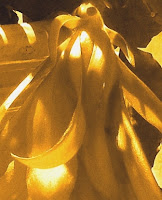LAVENDER BLUES (photo) & FOLLY (dreamku) by Roswila

her poem appears
on the computer screen
every edit
she’d ever made on it high-
lighted in lavender
each word cut out
over the years also back in
plastered in pastels
she deletes the ancient hodgepodge
thinking of it as a mercy
gone but in dreams beauty released from folly
[two tanka and a monoku on a dream of 4-12-12. I “heard” those last words “beauty released from folly” at the very end of the dream. As I drafted this dreamku I thought this can apply even more so to my photos. Photo “Lavender Blues” by Roswila]
Also, the photo accompanying a daily dream poem or non-dream based poem is not necessarily meant to illustrate it, but to reflect some small, even slant aspect of the verse -- similar to Japanese haiga (illustrated haiku). I've also recently realized that although the dreamku (i.e. dream based poems) posted here tend not to have metaphor or simile, the accompanying photos almost always act as such.
To write a metaphor or simile into a dream scenario is something I rarely do. It can be confusing: did it really look like a hand, say, in the dream, or am I just being poetic to make my conscious point? As these dreamku act as a dream journal, my over-riding tendency is to try to stay close to the actual dream scenario itself. Admittedly making for a tendency to less "poetic" dreamku. Then why pay attention to any haiku, tanka, or monoku parameters at all when writing about my dreams? Because I find in even attempting to adhere to them I'm making choices that relieve my dream recall of a great deal of chatter so that I can get down to some important dream aspects. Here's a link to THE AREN'TS OF DREAMKU & ACCOMPANYING PHOTOS in which I go into some of the basic parameters for dreamku and the photos chosen to go with them (and with any non-dream based poems I post here, as well).
The archives in the sidebar hold years of the daily dreamku, tanka, monoku and photo posts I've made, grouped in one post by month. As I no longer post dreamku (or non-dream based poems) strictly daily, each post will appear below and then in the archives by the day on which it was posted.
There are many other sorts of posts here, not all dream-based. I indicate which are about or influenced by dreams. Some non-dream focused posts are book reviews, "regular" poems (some by other writers than myself), scifaiku, writing exercises, Tarot haiku, photos, haiga, and so on. However, most of those are in much older posts. There's a listing by month going back to early 2006 in the sidebar.
‘til next time, keep dreaming,

[aka: Patricia Kelly]
**** If you wish to copy or use any of my writing or poems, please email me for permission (under “View my complete profile”) **** My other blogs: ROSWILA’S TAROT GALLERY & JOURNAL; ROSWILA’S TAIGA TAROT; and OPENING TO THE LIGHT ****





